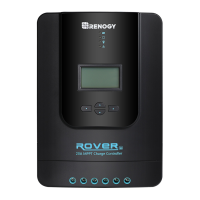07
The charge controller will reduce the voltage charge to smaller quantity, while lightly charging
the battery. The purpose for this is to offset the power consumption while maintaining a full
battery storage capacity. In the event that a load drawn from the battery exceeds the charge
current, the controller will no longer be able to maintain the battery to a Float set point and the
controller will end the float charge stage and refer back to bulk charging.
Equalization: Is carried out every 28 days of the month. It is intentional overcharging of
the battery for a controlled period of time. Certain types of batteries benefit from periodic
equalizing charge, which can stir the electrolyte, balance battery voltage and complete
chemical reaction. Equalizing charge increases the battery voltage, higher than the standard
complement voltage, which gasifies the battery electrolyte.
Once equalization is active in the battery charging, it will not exit this stage unless
there is adequate charging current from the solar panel. There should be NO load
on the batteries when in equalization charging stage.
Over-charging and excessive gas precipitation may damage the battery plates
and activate material shedding on them. Too high of equalizing charge or for too
long may cause damage. Please carefully review the specific requirements of the
battery used in the system.
Equalization may increase battery voltage to a level damaging to sensitive DC
loads. Ensure that all load allowable input voltages are greater than the equalizing
charging set point voltage.
WARNING
WARNING
WARNING
The Rover MPPT charge controller has a reactivation feature to awaken a sleeping lithium
battery. The protection circuit of lithium battery will typically turn the battery off and make it
unusable if over-discharged. This can happen when storing a lithium battery pack in a
discharged state for any length of time as self-discharge would gradually deplete the remaining
charge. Without the wake-up feature to reactivate and recharge batteries, these batteries would
become unserviceable and the packs would be discarded. The Rover will apply a small charge
current to activate the protection circuit and if a correct cell voltage can be reached, it starts a
normal charge.
Lithium Battery Activation

